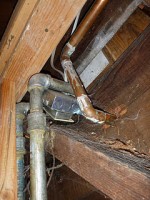One of the inspectors at my Region III class brought to my attention a process of disposing of human remains that is called biocremation alkaline hydrolysis that his community rejected after a mortuary sought approval. (Cloquet Council Votes No) It’s being promoted as a “green” process which includes liquifying the soft tissues of the body and the liquid is poured into the sewer system. It’s not legal in many states yet and there has been concerns raised in some places including California for a variety of reasons. There is research on using this method to dispose of animal carcasses that may have some bearing on its effect on the environment.
Yesterday when I was teaching at the Region III conference in Chasta, MN, one of the participants shared with us his experiences with Compliance Connections. It’s a website that allows municipal inspectors to get connected with the right entity to gain code compliance on a problem property. It’s sponsored by Safeguard and the inspector says he’s had unbelievable help from the website. He told us that he’s had grass cut in a couple of days, he’s gotten calls from service companies that aren’t owned by Safeguard to promise compliance and is very pleased with the results. Apparently, Safeguard is trying to reduce the number of notices of violation that lenders are receiving for vacant properties or problem properties in their portfolios. It is definitely worth checking out when you have difficulty determining who is responsible for a property. The website is located at http://www.complianceconnections.com/
I’d love to hear from people who have tried it.
A young woman lost her life in Chicago recently during a fire. The fire began in a unit in a high rise apartment building, the residents fled the fire but left the door open so one of their pets could escape, the unsuspecting woman took the elevator up to the floor where the fire had spread, and was overcome as soon as the doors opened up. The building did not have sprinklers, a fire alarm system or an automatic recall elevator system according to ABC news in Chicago. The City of Chicago had delayed forcing older building to conform to the fire code by extending the time for compliance in its ordinance. In an interesting development, the State Fire Marshal cited the building owner for 19 violations of the fire code including the above violations which violate the Life Safety Code. Building owners are now arguing that they are confused over which law to follow. The State of Illinois has adopted the Life Safety Code as its state code. Chicago has home rule powers but that doesn’t exempt buildings from following state law unless state law grants such a waiver. Unfortunately, Illinois is hodgepodge of laws. We don’t have a state building code. Local governments basically adopt whatever they deem proper for the locale though most of the cities and villages I know of do adopt the Life Safety Code in addition to the IFC as their local ordinances. The caselaw in this area uses a balancing test weighing the cost of the upgrades versus the safety of the public. The safety of the public usually prevails which is why owners can be forced to retrofit their buildings. We know what prevents loss of life in fires but the outcry from building owners that delay upgrades due to the cost too often results in loss of life.
I received a request that I post this question for all of my readers to answer. Do any of your jurisdictions have an ordinance allowing you to shut down a business if it is occupying the space without a certificate of occupancy? Certainly if the work is hazardous, an inspector can use emergency powers to do so. However, most of the cases don’t fall into this category. The way I usually handle those cases is to recommend that the inspector ticket the owner every day the business remains open. If that doesn’t work in a couple of days, the inspector starts giving tickets to the managerial staff, and if that doesn’t work, the inspector gives tickets to the employees (it doesn’t usually go that far). In Illinois, a defendant who commits an ordinance violation can also be arrested. I actually had a case where we gave the person a ticket in the morning, told them not to reoccupy the space, and then arrested him in the afternoon when the inspector found the business still operating. If anyone has something to share, I will post it and give you credit.
A very worrisome lawsuit has been filed by the Federal Housing Finance Agency which oversees Fannie Mae and Freddie Mac, against the City of Chicago which recently passed an ordinance that requires mortgage holders to register vacant buildings 30 days after they become vacant or 60 days after a mortgage goes into default, whichever is later, pay a registration fee, keep the premises free of weeds or trash and make sure they are structurally sound.
The lawsuit says that:
….the city’s ordinance encroaches on the FHFA’s role as the sole regulator and supervisor of Fannie Mae and Freddie Mac. It says Chicago cannot mandate how the agencies handle vacant buildings for which they are the designated mortgagee.
The problem is that Fannie Mae and Freddie Mac own about 258,000 mortgages in Chicago so a considerable number of vacant structures would be unregulated if the lawsuit succeeds. Illinois law makes it almost impossible for a municipality to cut weeds, fix up property and add the costs to the property tax bill. This has really hampered our ability to address problem properties which is why ordinances like the one in Chicago are so important.
A number of inspectors have shown an interest in the case of the Aspen inspector charged with negligent homicide because a family died of carbon monoxide poisoning in a residence he had inspected and have asked me about the outcome. The good news for the inspector is that the case was dismissed in November but without a finding as to whether he was immune from prosecution under the law. Instead the case was dismissed because the indictment failed to show that the matter occurred within the time set by the statute of limitations. The prosecution failed to plead the date of the deaths in the indictment. It was an odd ending to a very troubling case. The civil suits are still pending.
 One of the great unknowns is what lies behind the drywall when mechanical, plumbing and electrical work is covered up. I ran across a blog entry complete with photos of one man’s answer to this question at “Chez Neumansky, 3rd Time’s the Charm”. How many code violations can you spot? I wish him well on correcting all of the problems.
One of the great unknowns is what lies behind the drywall when mechanical, plumbing and electrical work is covered up. I ran across a blog entry complete with photos of one man’s answer to this question at “Chez Neumansky, 3rd Time’s the Charm”. How many code violations can you spot? I wish him well on correcting all of the problems.
I was recently contacted by a student doing a study about how code enforcement officers handle interactions with anti-government extremists. I’m fortunate that I haven’t encountered this type of threat very often but I promised her I would reach out to my readers to see if anyone has had to deal with this sort of problem. How have you handled it?
At the Springfield conference, my topic was effective code enforcement programs. After hearing about all of the substantive issues involving healthy homes, it was really a privilege to be able to speak about how to accomplish our mutual goals. There was a lot of frustration over the problems we are facing because budgets are being slashed, programs cancelled and properties are getting worse because of the foreclosure mess. Despite this, it was important to find out that there are a lot of committed professionals who are forming partnerships to address these issues. And, there are steps inspectors can take that don’t cost much money to implement, for example, making sure that renovators are certified in lead paint removal before issuing a building permit. Who knows how many health problems children are spared because of this simple procedure? The training in Springfield was offered free of cost as were many of the publications. I hope my readers will make use of the links I have created to find these organizations. I want to thank Eleanor Davis from the IDPH, Lead Paint Program, for inviting me to speak at the conference and giving me the opportunity to meet the other speakers. I hope it will lead to even better enforcement opportunities.
One of the most interesting speakers at the Springfield conference was Dr. Catherine Karr, who is a pediatric environmental health specialist. She reviewed a wide variety of home health hazards including lead paint, radon, mold, carbon monoxide, fire, and pests. So many of these topics intersect with property maintenance and fire prevention enforcement. She is a member of a group called PEHSU (Pediatric Environmental Health Specialty Units) which is a national network of academic-based centers of expertise that service health care providers, public health professionals, communities and families. Asthma, for example, is a huge health problem for children and adults and is made worse by living in homes that have mold problems and pest infestation. Illinois is included in the Great Lakes Centers’ Pediatric Environmental Health Specialty Unit based at the University of Illinois at Chicago. All areas of the country are part of some regional unit. PEHSU is a great resource for information on all of these issues. When inspectors are dealing with a property where children live, the long term effects of the unhealthy conditions should be a top priority for enforcement.


